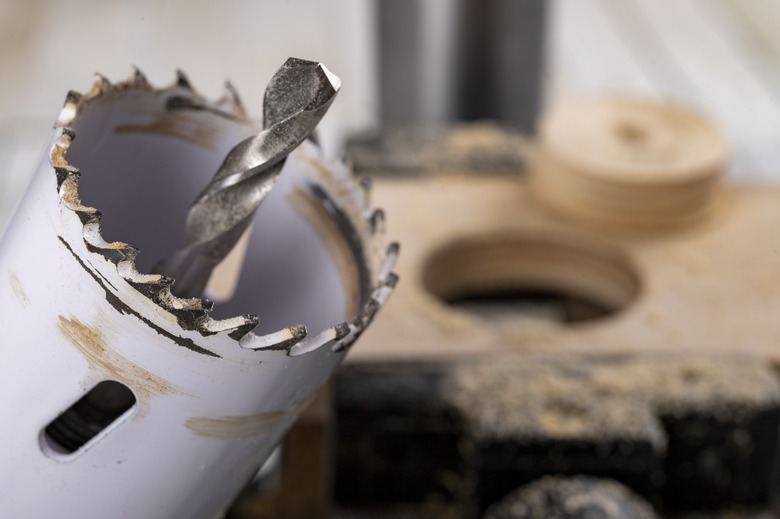How To Attach A Hole Saw To A Drill
We may receive a commission on purchases made from links.
When you're working with wood, you can drill holes up to 1 1/2 inches in diameter with a spade bit or Forstner bit, but when it comes to larger diameters, you need a hole saw. It's a cylindrical tube with cutting teeth on one side, and it can make holes up to 4 3/4 inches in diameter. The resistive force the hole saw develops increases with the diameter of the saw, so to safely make holes larger than that, you have to do it a jig saw.
Even small-diameter hole saws create a fair amount of centrifugal force and must be securely attached to the drill to prevent them from coming loose. Fortunately, most drills can handle the job as long as you install the hole saw properly.
Putting a Hole Saw Together
Putting a Hole Saw Together
The part of a hole saw that cuts the actual hole is a heavy-duty steel cylinder with an open end and a closed end. The open end is the one with teeth that does the cutting, while the closed end has a hole in the middle that accepts a removable pilot bit. The pilot bit is needed to center the saw on the material being drilled, and it has a hexagonal shank on the opposite end that fits into the drill chuck.
You assemble the hole saw by slipping the pilot bit through the hole in the closed end of the saw and pushing it up until it locks into the hole. Some pilot bits have ferrules that fit into matching holes on the end of the saw to make a more secure connection. Once the bit is in place, you screw the locking nut that comes with the saw assembly onto a threaded arbor and tighten it by hand to prevent the saw from slipping while the bit is spinning.
Inserting a Hole Saw in a Drill
Inserting a Hole Saw in a Drill
Once the saw is locked onto the pilot bit, you insert the bit into your drill the same way you would insert any bit: Loosen the chuck, insert the bit, and tighten down the chuck. Older drills have chuck keys that allow you to torque down on the chuck to make it really tight, but most modern drill chucks need to be tightened by hand.
When you're inserting a conventional drill bit into a chuck that has no chuck key, the easiest way to tighten the chuck is to hold it with one hand while you operate the drill with the other. You can't get the chuck tight enough to hold a hole saw using that method, especially a large-diameter one. You need to hold the chuck and tighten it firmly by hand.
How to Drill a Hole
How to Drill a Hole
Once the hole saw is assembled and installed in the drill, place the pilot bit on the center of the hole you want to drill and operate the drill at a low speed to get it to bite into the wood without wandering. Once the bit bites, increase the speed until the saw makes contact. At that point, you need to hold the drill securely because the centrifugal force of the saw creates a tendency for the drill to spin in the opposite direction. When drilling a large hole, a drill with an auxiliary handle is recommended because it gives you more control.
Once the saw starts cutting, keep the drilling speed constant and the angle of the drill perpendicular to the surface you're drilling and let the saw do the work. In most cases, you'll want to drill just deep enough for the pilot bit to emerge from the other side and then switch to that side to finish the hole. This prevents the saw from tearing the edges of the hole as it emerges.
